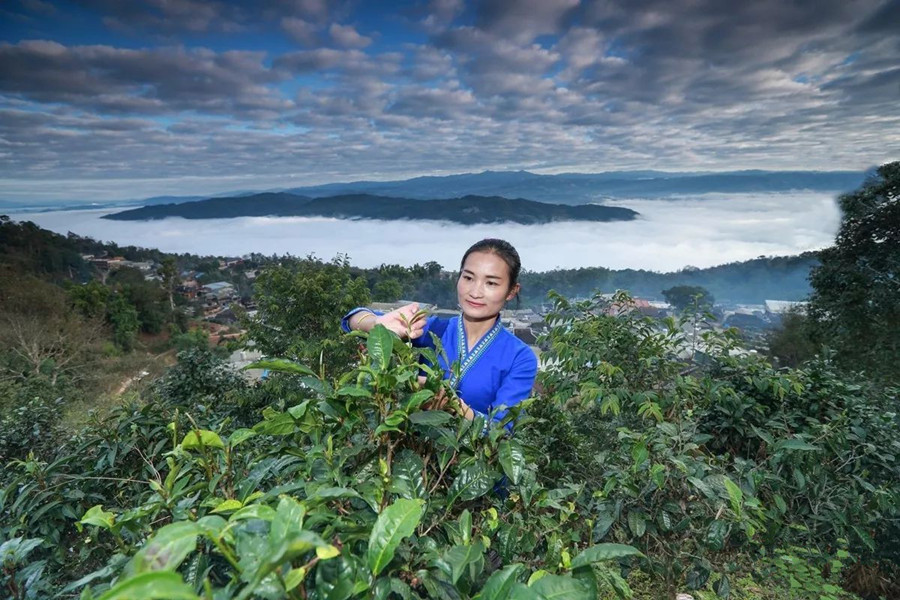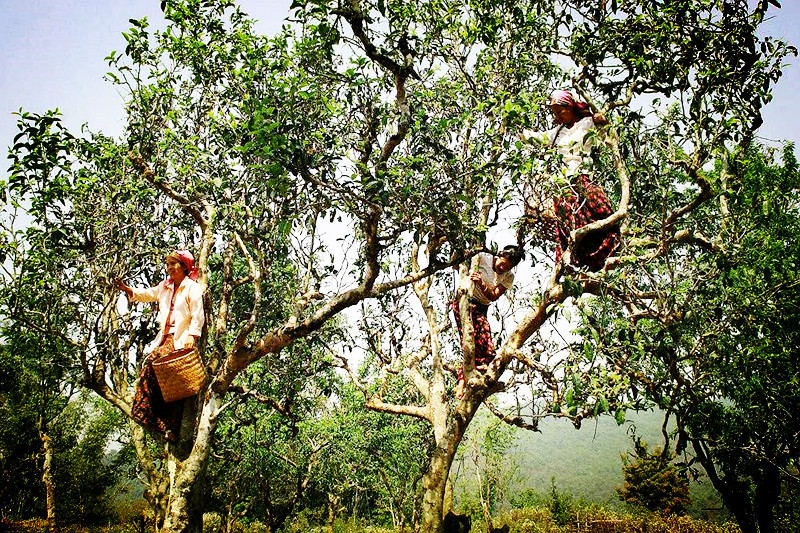
Top 8 Puer Tea Plantation Villages in Jingmai Tea Mountain
Eight Key Tea Villages of Jingmai Ancient Tea Mountain
Jingmai Ancient Tea Mountain, known for its thousand-year-old tea gardens, is located at the southernmost end of Huiming Township in Lancang Lahu Autonomous County, the only such county in southwest China. The Jingmai Tea Mountain area is divided into two administrative villages: Jingmai and Mangjing, covering a total area of 66.9 square kilometers. The area includes 8 natural villages with 598 households and 2,635 people. The ancient tea gardens are situated at altitudes between 1,000 and 1,500 meters. Jingmai Village is a highland Dai ethnic village, where the local people primarily grow rice, dry rice, and corn, with tea being the main economic source for generations, involving the protection, cultivation, and sale of tea.
Here are some of the main tea villages, highlighted as key points.
Mangjing – Manghong Village/芒景-芒洪村
Manghong is located at the southernmost end of Mangjing. The westernmost part of the village features the Eight-Sided Tower, a testament to the introduction of Buddhism into the Blang mountain area. The village is arranged to the east from this point, with the village center reflecting the stone worship of the village heart. Manghong’s houses are built around this central point, which is believed by the Blang people to protect and bless the community. The “King of Tea Trees” is regarded as a sacred tree in Manghong, representing the Blang people’s natural worship of the tea deity.
Mangjing – Wengji Village/芒景-翁基村
Wengji and Nuo Gan are the two most well-preserved villages in the Jingmai-Mangjing region, with their architectural styles well-maintained. At the northern end of the village is the Wengji Ancient Temple, the oldest Buddhist temple on Jingmai Mountain. To the west of Wengji Ancient Temple stands an ancient cypress tree with a trunk diameter of 11 meters and a height of over 20 meters, estimated to be 2,000 to 3,000 years old. The cypress and the ancient temple are intertwined, providing shade, and are referred to by locals as “Ancient Cypress Listening to the Sutras.” The village houses are separated from the ancient temple by external roads. The heart of Wengji Village is located at the village center, with residential buildings arranged in a typical concentric layout, densely built at the northern end and tapering off towards the southern end, forming a roughly inverted triangular shape, ending at the public building – the rain shelter.
Mangjing – Mangjing Shangzhai/芒景-芒景上寨
Mangjing Shangzhai is located in the central part of the Blang ethnic village in the southern part of Jingmai Mountain. It includes both the new Mangjing Zhai and the Mangjing Shangzhai. To the northwest of Shangzhai is the Pa Ailong Temple, an important religious site for both Shangzhai and Xiazhai, built to commemorate the Blang ancestor Pa Ailong. At the northern end of Shangzhai’s mountain is the Bee God Tree, a centuries-old banyan tree worshipped by the Blang people. The village is arranged concentrically with a village center featuring the Princess Spring and Princess Banyan. Between Shangzhai and Xiazhai is the Mangjing Tea Museum, showcasing the history of Pu’er tea development.

Mangjing – Mangjing Xiazhai/芒景-芒景下寨
Mangjing Xiazhai is located in the central part of the Blang ethnic village in the southern part of Jingmai Mountain, south of Mangjing Shangzhai. The residential buildings in Xiazhai are arranged concentrically around the village center. The eastern end features an ancient cypress tree, and the northern mountainous area contains the Barong Tribe ruins, Barong trench ruins, Princess Tomb, and Tea Soul Platform, an important sacrificial site for the Blang’s mountain festival. The village preserves multiple sites related to Pa Ailong and Princess mythology, reflecting the cultural heritage of Pa Ailong and the evolution of Pu’er tea.
Jingmai – Manggang Village/景迈-芒埂村
Manggang is located on the northeast side of Jingmai Mountain. The overall architectural style of the village is relatively harmonious, arranged on the north side of the ridge, with buildings decreasing in height from south to north. Manggang is adjacent to Mengben Village, with similar village layouts, both following a concentric pattern. The village center of Manggang consists of the adjacent Sadi Temple, village heart, and Sadi Tomb, with water features such as Jinshuitang positioned near the village core, reflecting the close connection between Dai customs and water bodies.
Jingmai – Mengben Village/景迈-勐本村
Mengben is located on the northeast side of Jingmai Mountain, adjacent to Manggang. The village layout is on the north side of the ridge, with buildings decreasing in height from south to north. Mengben Village follows a concentric pattern, with the temple (Jinta Temple) separated from the village center, with the village buildings arranged around the village heart.

Jingmai – Jingmai Dazhai/景迈-景迈大寨
Jingmai Dazhai, located on the northern slope of Jingmai Mountain, has seen rapid economic development, resulting in many new buildings. The village buildings face the northeast, with the overall layout decreasing from southwest to northeast. To the east of the village is Dazhai Longshan, where Dai residents are buried after death. To the southwest, close to the main peak of Jingmai Mountain, the ancient tea road (Tea Horse Road) winds up from the south side of the village. The village center includes Dazhai Temple and Dazhai Sacred Spring, with surrounding buildings showing a concentric layout. As the distance from the village center increases, the village layout transitions from concentric to a grid-like pattern.

Jingmai – Nuo Gan/景迈-糯干
Nuo Gan Old Village, located on the northwest side of Jingmai Mountain, is a traditional village with a distinctive traditional landscape layout. The overall architectural style is well-preserved and is one of the two ancient villages fully preserved within the heritage area. The village is situated in a valley, with temples and observation platforms located on the northern and southern hills, respectively. The internal topography of the village is relatively flat. Nuo Gan Old Village features a typical concentric layout, with the village center as the village heart, and the temple located on the northern hilltop. Due to the relatively low terrain, streams and lakes gather here, with the water system in the village following the building layout, eventually converging at the village entrance, becoming a key element in the village layout.

 7 Days GolfingTour
7 Days GolfingTour
 8 Days Group Tour
8 Days Group Tour
 8 Days Yunnan Tour
8 Days Yunnan Tour
 7 Days Shangri La Hiking
7 Days Shangri La Hiking
 11 Days Yunnan Tour
11 Days Yunnan Tour
 6 Days Yuanyang Terraces
6 Days Yuanyang Terraces
 11 Days Yunnan Tour
11 Days Yunnan Tour
 8 Days South Yunnan
8 Days South Yunnan
 7 Days Tea Tour
7 Days Tea Tour
 8 Days Muslim Tour
8 Days Muslim Tour
 12 Days Self-Driving
12 Days Self-Driving
 4 Days Haba Climbing
4 Days Haba Climbing
 Tiger Leaping Gorge
Tiger Leaping Gorge
 Stone Forest
Stone Forest
 Yunnan-Tibet
Yunnan-Tibet
 Hani Rice Terraces
Hani Rice Terraces
 Kunming
Kunming
 Lijiang
Lijiang
 Shangri-la
Shangri-la
 Dali
Dali
 XishuangBanna
XishuangBanna
 Honghe
Honghe
 Kunming
Kunming
 Lijiang
Lijiang
 Shangri-la
Shangri-la
 Yuanyang Rice Terraces
Yuanyang Rice Terraces
 Nujiang
Nujiang
 XishuangBanna
XishuangBanna
 Spring City Golf
Spring City Golf
 Snow Mountain Golf
Snow Mountain Golf
 Stone Mountain Golf
Stone Mountain Golf













